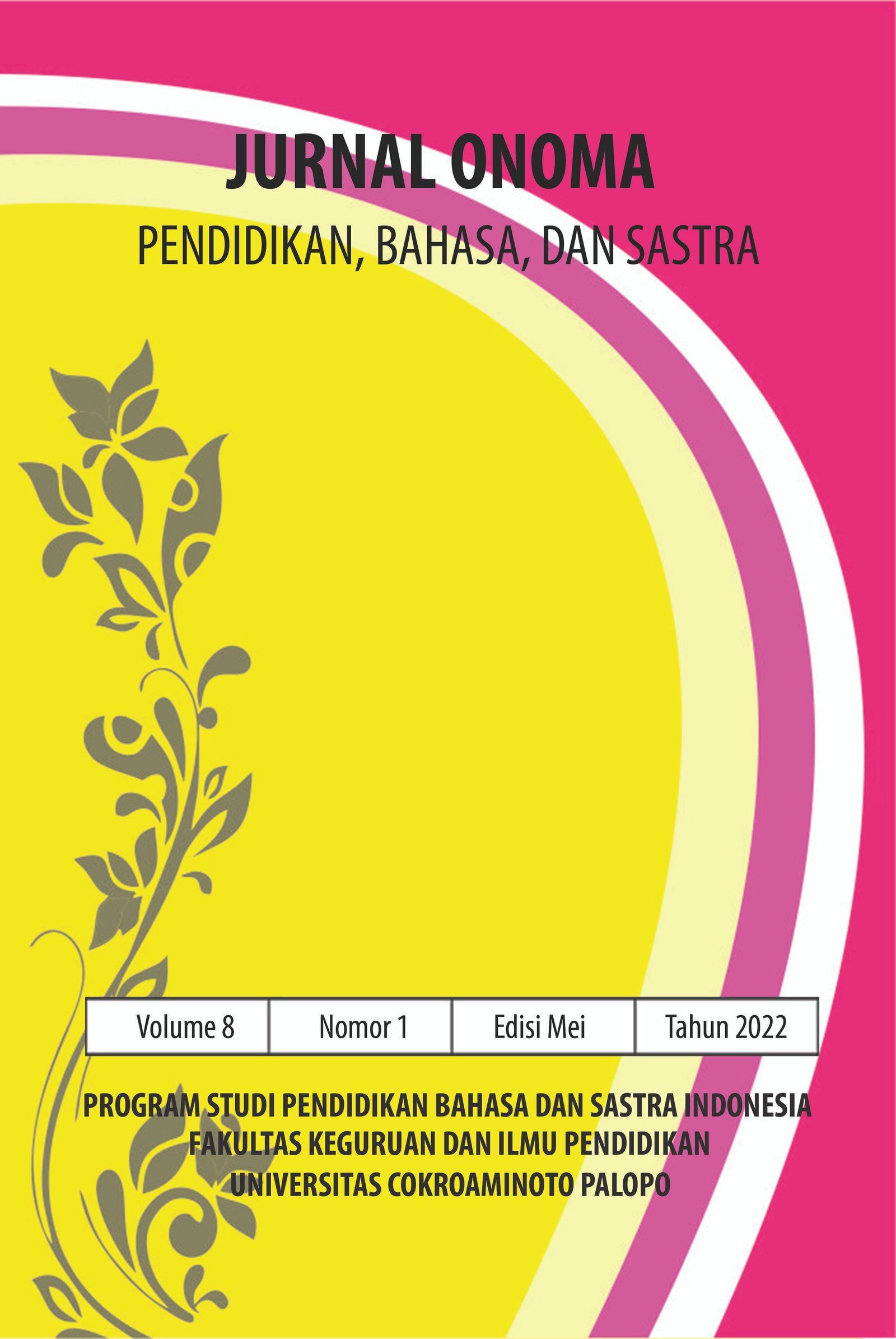Masalah Sosial dalam Novel La Muli Karya Nunuk Y. Kusmiana
https://doi.org/10.30605/onoma.v8i1.1412
Keywords:
Masalah Sosial, Novel, Sosiologi SastraAbstract
Penelitian ini bertujuan untuk mendeskripsikan unsur intrinsik dalam novel La Muli karya Nunuk Y. Kusmiana, dan mendeskripsikan masalah sosial dalam novel La Muli karya Nunuk Y. Kusmiana. Peneliti merumuskan dua masalah dalam penelitian ini yaitu, Bagaimana unsur intrinsik dalam novel La Muli karya Nunuk Y. Kusmiana? Dan Bagaimana masalah sosial dalam novel La Muli karya Nunuk Y. Kusmiana melalui pendekatan sosiologi sastra? Teori yang digunakan yaitu sosiologi sastra yang terfokus pada sosiologi karya sastra dan teori yang digunakan untuk menganalisis masalah sosial yaitu teori Soekanto Soerjono. Penelitian ini menggunakan pendekatan kualitatif. Sedangkan, metode penelitian yang digunakan adalah metode deskriptif analisis. Sumber data yang digunakan dalam penelitian ini adalah novel La Muli karya Nunuk Y. Kusmiana. Hasil penelitian ini menunjukan terdapat, pertama menjelaskan unsur intrinsik dalam novel yang terdiri dari tema, tokoh dan penokohan, alur, latar, sudut pandang, dan amanat. Kedua, menjelaskan masalah sosial yang terdiri dari kemiskinan, kejahatan, disorganisasi keluarga, masalah generasi muda dalam masyarakt modern, peperangan, pelanggaran terhadap norma masyarakat, masalah kependudukan, masalah lingkungan hidup, birokrasi.
Downloads
References
Aminuddin. (2015). Pengantar Apresiasi Sastra. Sinar Baru Algensindo.
Darmawati, U. (2018). Prosa Fiksi Pengetahuan dan Apresiasi. PT. Intan Pariwara.
Darti Muflikhah , Andayani, R. S. (2014). Masalah Sosial dalam Novel Air Mata Tjitanduy karya Bambang Setiaji. I(April), 437–447.
Faruk. (2017). Pengantar Sosiologi Sastra. Pustaka Pelajar.
Kusmiana, N. Y. (2020). La Muli. Basabasi.
Moleong, L. j. (2010). Metodologi Penelitian Kualitatif. Remaja Rosdakarya.
Nurgiyantoro, B. (2015). Teori Pengkajian Fiksi. Gajah Mada University Press.
Ratna, N. K. (2015). Teori, Metode, dan Teknik Penelitian Sastra: dari Strukturalisme hingga Postukturalisme Persektif Wacana Naratif. Pustaka Pelajar.
Sehandi, Y. (2018). Mengenal 25 Teori Sastra. Penerbit Ombak.
Soekanto, S. (2015). Sosiologi Suatu Pengantar. PT. Rajagrafindo Persada.
Syafrona, A. (2013). MASALAH SOSIAL DALAM NOVEL REMBULAN TENGGELAM DI WAJAHMU KARYA TERE LIYE : KAJIAN SOSIOLOGI SASTRA. 241–248.
Werren dan Wellek. (2016). Teori Kesusastraan. Gramedia.
Wiyatmi. (2009). Pengantar Kajian Sastra. Pustaka Book.
Wiyatmi. (2013). Sosiologi Sastra: Teori dan Kajian terhadap Sastra Indonesia. 1–159. staffnew.uny.ac.id/upload/131873962/pendidikan/Bahan+ajar+Sosiologi+Sastra.pdf
Downloads
Published
How to Cite
License
In submitting the manuscript to the journal, the authors certify that:
- They are authorized by their co-authors to enter into these arrangements.
- The work described has not been formally published before, except in the form of an abstract or as part of a published lecture, review, thesis, or overlay journal.
- That it is not under consideration for publication elsewhere,
- That its publication has been approved by all the author(s) and by the responsible authorities – tacitly or explicitly – of the institutes where the work has been carried out.
- They secure the right to reproduce any material that has already been published or copyrighted elsewhere.
- They agree to the following license and copyright agreement.
License and Copyright Agreement
Authors who publish with Onoma Journal: Education, Languages??, and Literature agree to the following terms:
- Authors retain copyright and grant the journal right of first publication with the work simultaneously licensed under Creative Commons Attribution License (CC BY 4.0) that allows others to share the work with an acknowledgment of the work's authorship and initial publication in this journal.
- Authors are able to enter into separate, additional contractual arrangements for the non-exclusive distribution of the journal's published version of the work (e.g., post it to an institutional repository or publish it in a book), with an acknowledgment of its initial publication in this journal.
- Authors are permitted and encouraged to post their work online (e.g., in institutional repositories or on their website) prior to and during the submission process, as it can lead to productive exchanges, as well as earlier and greater citation of published work.

















